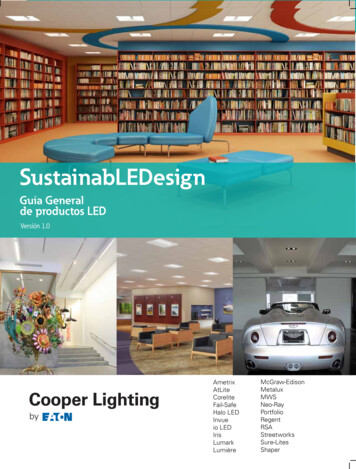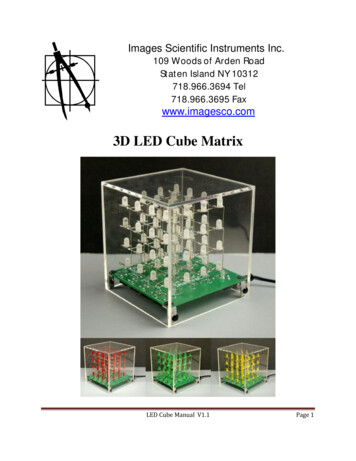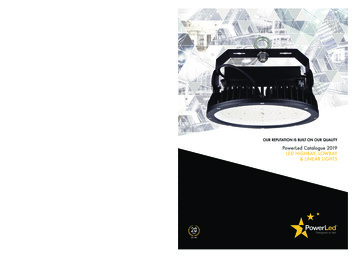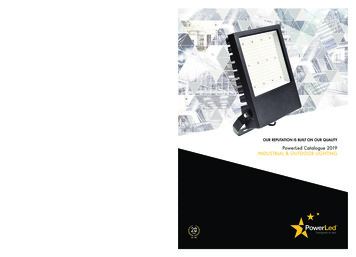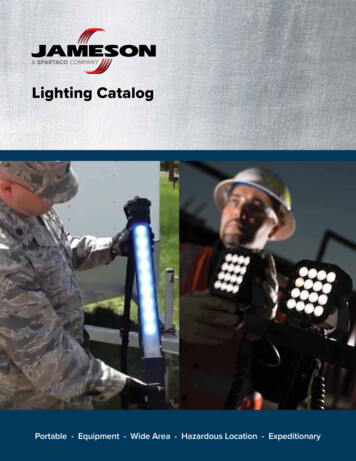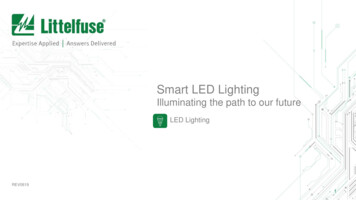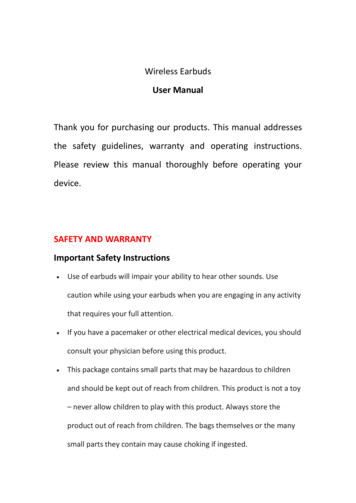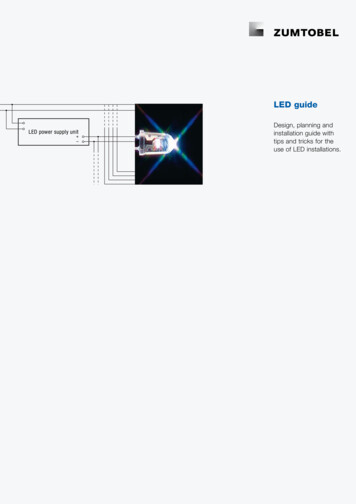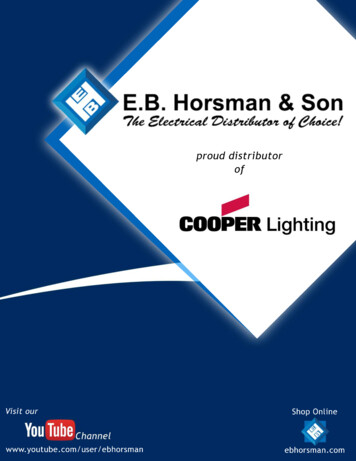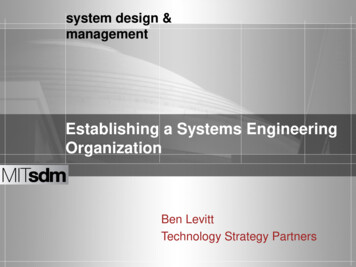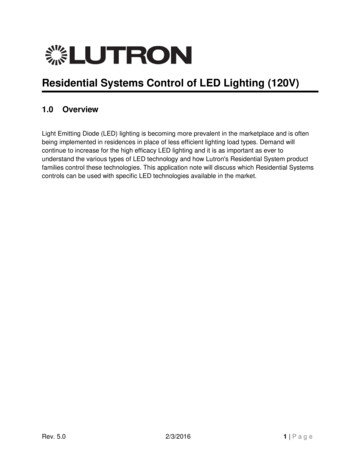
Transcription
Residential Systems Control of LED Lighting (120V)1.0OverviewLight Emitting Diode (LED) lighting is becoming more prevalent in the marketplace and is oftenbeing implemented in residences in place of less efficient lighting load types. Demand willcontinue to increase for the high efficacy LED lighting and it is as important as ever tounderstand the various types of LED technology and how Lutron's Residential System productfamilies control these technologies. This application note will discuss which Residential Systemscontrols can be used with specific LED technologies available in the market.Rev. 5.02/3/20161 Page
Table of Contents1.0Overview . 12.0LED Tools and Resources . 33.0LED Technology and Residential Systems Applications . 33.1Line Voltage LED Control with Integrated Drivers (LEDi) . 43.2Line Voltage LED Control with External Drivers . 53.30-10V (Current Sink) . 73.40-10V (Current Source) . 73.5Pulse Width Modulation (PWM) Control . 73.6Digital Addressable Lighting Interface (DALI) Control . 83.7EcoSystem . 83.8DMX512 Control . 84.0Setting High and Low End Trim . 94.1 Adjusting Trim Settings in the RadioRA 2 Programming Software . 94.2 RadioRA 2 Low End Trim Tool .104.3 Adjusting Trim Settings in the HomeWorks QS Programming Software .134.4 HomeWorks QS Low End Trim Tool .145.0Using an LUT-LBX as an Active Load .156.0FAQs.16Rev. 5.02/3/20162 Page
2.0LED Tools and ResourcesThroughout this application note, various LED and Lighting Control technologies will bereferenced such as 0-10V dimming, DMX 512, forward and reverse phase control. For moredetailed information on these technologies, please refer to the Controlling LEDs White Paper(p/n 367-2035) which is available at www.lutron.com/led, by clicking on the White Papers linkunder the Resources tab of the LED light sources page.It is also important to note that Lutron performs its own LED testing with lamps/fixtures from amultitude of 3rd party manufacturers. Lamps/fixtures that pass the full set of testing and meet thetechnical and performance requirements are deemed “Recommended.” Recommendedlamps/fixtures are then placed into the LED Product Selection tool, along with their ReportCards which detail product specific performance. The Product Selection Tool is a drop downmenu selection tool which can help one find Recommended lamps/fixtures based on LampManufacturer, Lamp/Fixture type, or even Lutron product family. The Product Selection Tool islocated at www.lutron.com/ledtool.A video on how to use the tool can be found in the LED section of lutron.com. Click here to viewthe video.3.0LED Technology and Residential Systems ApplicationsThis section focuses on the specific variations of LED technologies which are prevalent in themarket today and how the technologies interact with RadioRA 2 and Homeworks QS products.For more information on specific LED technology variations, as well as Product Compatibility,please visit www.lutron.com/led.Rev. 5.02/3/20163 Page
3.1Line Voltage LED Control with Integrated Drivers (LEDi)LED lamps/fixtures with integrated drivers are common. Many are direct replacements ofincandescent lamps with the driver residing in the base of the lamp itself. In these cases, thedimmer is actually sending a signal to the driver which subsequently controls the lightingelement. The driver technology varies greatly from lamp to lamp. Some integrated drivers workwell with forward phase, triac-based dimmers, while others perform better with reverse phasedimming.The following chart displays the wall mounted dimmers which are UL Listed to control up to150W of recommended LED lighting loads. To determine if the dimmer is compatible withspecific LEDi lamps, refer to the LED Product Selection Tool at www.lutron.com/ledtool.RadioRA 2RRD-6NARRD-6CLRRD-10NDHomeWorks QS 10NDThe following chart displays the wall mounted dimmers which are UL Listed to control up to250W of recommended LED lighting loads. To determine if the dimmer is compatible withspecific LEDi lamps, refer to the LED Product Selection Tool at www.lutron.com/ledtool.RadioRA 2RRT-G25LWRRT-GHxBRRT-G5NEWHomeWorks QS (120V)HQRT-G25LWHQRT-GHxBHQRT-G5NEWThe following chart displays the dimmers which are UL Listed to control up to 100W ofrecommended LED lighting loads. To determine if the dimmer is compatible with specific LEDilamps, refer to the LED Product Selection Tool at www.lutron.com/ledtool.RadioRA 2RRD-3LDRRD-3PDRRD-HNxRRD-HxRev. 5.0HomeWorks QS (120V)HQR-3LDHQR-3PDHQRx-HNyHQRx-Hy2/3/20164 Page
It is also possible to control these types of LED lamps with centralized dimming modules andinterfaces. To determine if the dimming module is compatible with specific LEDi lamps, refer tothe LED Product Selection Tool at www.lutron.com/ledtool.RadioRA 2Grafik Eye QS (QSGRJ-xP)LQRJ-WPM-6P-1203.2HomeWorks QS (120V)Grafik Eye QS 201GP (Harrier) Card1Line Voltage LED Control with External DriversSome LED fixtures on the market have the LED lighting element separate from the driver. Thedriver fits into the system similarly to that of fluorescent ballasts, mounting within the fixture. Aswith integrated drivers, the dimmer is actually controlling the driver, which then controls thelighting element appropriately. To determine if the dimming control is compatible with a specificLED lamp with external driver, refer to the LED Product Selection Tool atwww.lutron.com/ledtool.RadioRA RD-HNxHomeWorks QS 10NDHQRT-G25LWHQRT-GHxBHQRT-G5NEWHQRx-HNyRadioRA 2RRD-3LDRRD-3PDHomeWorks QS (120V)HQR-3LDHQR-3PDRadioRA 2Grafik Eye QS (QSGRJ-xP)LQRJ-WPM-6P-120HomeWorks QS (120V)Grafik Eye QS 201GP (Harrier) Card11Requires a system keypad to control the centralized lighting zones of this deviceRev. 5.02/3/20165 Page
Lutron manufactures its own LED Driver, part of the Hilume product family. The Hi-lume A Series LED driverfrom Lutron offers smooth and continuous LEDdimming with a 1% low end for all approved LEDfixtures. The A Series driver is compatible with LutronIvalo lighting fixtures as well as 3rd party fixtures and isavailable in both constant current and constant voltageconfigurations. The A Series driver is available in twoformats from an input standpoint: forward phasecontrol and 3 wire control. A list of current approved 3rd party fixtures is available fromwww.lutron.com (p/n 368-2817). The LED Product Selection Tool, at www.lutron.com/ledtool,can also be used to determine compatibility. Many 3rd party fixtures can be ordered to ship withthe Lutron driver built into the fixture.For control of the 3 wire Lutron Hi-lume A Series LED driver, the 120/277V 3 Wire FluorescentDimmer can be used. The brass terminal provides a constant hot for the driver(s) while theorange control wire passes the control signal to the driver(s) in order for the driver(s) todetermine the light output necessary to match the desired light level output.RadioRA 2RRD-F6AN-DVHomeWorks QS (120V)HQRx-F6AN-DVFor control of the forward phase Lutron Hi-lume A Series LED driver, neutral based ResidentialSystems products can be used for control. These products include both local and morecentralized control options. Note that phase selectable or adaptive products must be set toforward phase.RadioRA 2RRD-6NARRD-10NDGrafik Eye QS xBRRD-HNx2HomeWorks QS ik Eye QS 1202GP (Harrier) Card2HQRT-G25LWHQRT-G5NEWHQRT-GHxBHQRx-HNyRequires a system keypad to control the centralized lighting zones of this deviceRev. 5.02/3/20166 Page
3.30-10V (Current Sink)With 0-10V dimming, there are two methods for control of the LED light source. The 0-10Vdimming method is determined by which device is the 0-10V source for the LED lighting. Incurrent sinking, a driver provides the 0-10V source and a separate device controls the ballast. Inour Residential Systems, there are a few ways to control this type of technology. Again, refer tothe LED Product Selection Tool for a list of compatible products (www.lutron.com/ledtool).RadioRA 2GRX-TVI3LMJ-5T-DV-B43.4HomeWorks QS (120V)GRX-TVI3GRX-TVM2 Module4LMJ-5T-DV-B40-10V (Current Source)The other type of 0-10V dimming technology is called current source where the control device isproviding the source to the LED lighting as opposed to a driver. Refer to the LED ProductSelection Tool for a list of compatible products (www.lutron.com/ledtool).RadioRA 2LMJ-5T-DV-B43.5HomeWorks QS (120V)GRX-TVM2 Module4LMJ-5T-DV-B4Pulse Width Modulation (PWM) ControlPWM is a control protocol implementing a square wave signal, utilizing the corresponding onand off time ratio, within a fixed period of time per cycle, to determine the intensity level. Per IECstandards, maximum light level is obtained when providing more off time than on time. Refer tothe LED Product Selection Tool for a list of compatible products (www.lutron.com/ledtool).HomeWorks QS (120V)GRX-PWM-250GRX-TVM2 Module434Requires a neutral wire dimmer to controlRequires a system keypad to control the centralized lighting zones of this deviceRev. 5.02/3/20167 Page
3.6Digital Addressable Lighting Interface (DALI) ControlDALI is another form of low voltage lighting control that is used to send digital intensityinformation to an LED driver or multiple drivers. Refer to the LED Product Selection Tool for alist of compatible products (www.lutron.com/ledtool).HomeWorks QS (120V)GRX-TVM2 Module53.7EcoSystemEcoSystem is Lutron’s DALI extension, designed to ensure compatibility between all EcoSystemcontrols and EcoSystem ballasts and drivers. Digital information is passed from the control tothe ballast or driver via a two wire communication bus or loop which can contain up to 64ballasts or drivers. Any fixture containing an EcoSystem driver or Eco Enabled chip will be ableto activate to an EcoSystem control.HomeWorks QS (120V)LQSE-2ECO5Grafik Eye QS (QSGRJ-xE)3.8DMX512 ControlDMX512 is yet another low voltage lighting protocol and integration protocol which is oftenutilized with Cyan-Magenta-Yellow (CMY) or Red-Green-Blue (RGB) lighting technology whichutilizes three different LED colors to produce colors throughout the entire visible spectrum.Intensity values and colors used can be defined in the programming of the Lutron system. Referto the LED Product Selection Tool for a list of compatible products (www.lutron.com/ledtool).HomeWorks QS (120V)QSE-CI-DMX5For more information on how to program DMX technology with a HomeWorks QS system, referto the application note and supplementary training video located on the HomeWorks QS dealersite at http://resi.lutron.com. (Qualified Accounts only)5Requires a system keypad to control the centralized lighting zones of this deviceRev. 5.02/3/20168 Page
4.0Setting High and Low End TrimSome LED loads will require adjustments to be made to the dimming range of the dimmer inorder to perform at the highest possible level for the end user. Adjustments of low end and highend trim settings of the dimming control eliminate potential undesirable issues such asflickering, shimmering, pop-on, or dead travel.Recommended trim settings can be found, for all approved LED fixtures and loads, using theLED Product Selection Tool at http://www.lutron.com/ledtool. Trim settings can also bedetermined by on-site testing with the aid of the system programming utility. Required trimsettings can be entered on a per zone basis using the system programming utility and arechanged on a device level during system database transfers.4.1 Adjusting Trim Settings in the RadioRA 2 Programming SoftwareLow and High end trim can be adjusted using the RadioRA 2 Programming Software on acontrol by control basis. To adjust these trim settings, locate the dimming control to be adjusted,within the Design tab of the software, and then right-click on the image of the control.In the menu that appears, click on Advanced Settings.Rev. 5.02/3/20169 Page
The Advanced Settings window will appear for the dimming control. Low end and high end trimsettings can be adjusted here, as needed.Some LED fixtures or lamps may require the phase control of adaptive phase control devices tobe locked in either Reverse or Forward phase, as opposed to Auto-Detect. Phase control canbe set in Advanced Settings. Only change this setting if directed to do so by the LED ReportCard for the specific LED fixture or lamp that is being controlled.4.2 RadioRA 2 Low End Trim ToolIf a customer is not satisfied with the performance of LED lamps at low end, the RadioRA 2Programming Software offers a tool to aid in finding an appropriate low end. This tool will allowyou to modify the low end in real time to find a satisfying low end.Locate the Verify Low End feature in the Tools menu of the software.Rev. 5.02/3/201610 P a g e
In the window that appears, select the lighting zone, on the left, that you would like to edit thelow end trim setting for. Once the appropriate zone has been selected, click on Find Better LowEnd to begin the adjustment.Rev. 5.02/3/201611 P a g e
The low end can be tuned using the Auto Increment feature or by Fine Tuning the low endsetting manually using the up and down arrow buttons in the software. Once the desired lowend is achieved, click on Save Low End.NOTE: Clicking on Save Low End passes the new Low End Trim setting to the device. Adatabase transfer is not required.Rev. 5.02/3/201612 P a g e
4.3 Adjusting Trim Settings in the HomeWorks QS Programming SoftwareLow and High end trim can be adjusted using the HomeWorks QS Programming Software on azone by zone basis. To adjust these trim settings, locate the dimming control to be adjusted,within the Design Controls tab of the software, and then click on View Properties for thecorresponding Device Location.The low and high end trim settings for each local dimming control can be found in the Propertiestab of the Device Location Properties window.Low and high end trim settings can also be adjusted at the load, as opposed to the control, byfinding the appropriate load in the Design Loads tab of the programming software. Note that itmay be necessary to use the Customize Columns menu to make the trim settings visible (checkthe boxes for Low and High End).Rev. 5.02/3/201613 P a g e
4.4 HomeWorks QS Low End Trim ToolIf a customer is not satisfied with the performance of LED lamps at low end, the HomeWorksQS Programming Software offers a tool to aid in finding an appropriate low end. This tool willallow you to modify the low end in real time to find a satisfying low end.Locate the Verify Dimmer Low End feature in the Tools menu of the software.In the window that appears, select the lighting zone, on the left, that you would like to edit thelow end trim setting for. Once the appropriate zone has been selected, click on Find Better LowEnd to begin the adjustment.Rev. 5.02/3/201614 P a g e
The low end can be tuned using the Auto Increment feature or by Fine Tuning the low endsetting manually using the up and down arrow buttons in the software. Once the desired lowend is achieved, click on Save Low End.NOTE: Clicking on Save Low End passes the new Low End Trim setting to the device. Adatabase transfer is not required.5.0Using an LUT-LBX as an Active LoadDimming LEDs can prove to be difficult. In some instances, instability such as flickering orissues (particularly at low end) with the LED load can be corrected by adding a simulatedresistive load into the dimming control output circuit. Lutron manufactures an active load device,the LUT-LBX. The LUT-LBX is a 10W solid state load which simulates a 50W resistive load onthe output of the dimming control.LED loads will meet the minimum load requirements while in the ON or conducting state but,when attempting to turn the LED load OFF, can pose minimum load issues for the dimmingcontrol. This issue often manifests itself when the LED load never fully turns off even when thedimming control is sent into the OFF state. The LUT-LBX provides more than enough simulatedresistive load to meet the minimum load requirements of all Lutron dimming controls.The LUT-LBX must be either surface or recessed mounted. Surface mounting would require aprovided junction box (Lutron P/N 241-496). For more information, refer to the specificationsubmittal document: -LBX-1.pdf.Rev. 5.02/3/201615 P a g e
6.0FAQsIf the information contained on the packaging indicates that the LED lamp is dimmable,does that mean that it will be compatible with Lutron Residential Systems dimmingproducts?The definition of compatible is one that is subjective. If a lamp only dims to a low end of 50%, isthat truly dimmable? While the light level technically changes, Lutron strives to provide itscustomers with a high quality solution driven by high performance. Lamps must have a widerange of dimming without flicker, shimmer, and pop-on in order to meet the criteria of beingcompatible with our dimming products. Ideally, the dimming range and performance should bevery close or essentially equivalent to that of an incandescent lamp.I cannot find a specific lamp or fixture on the LED Product Selection Tool. Now what do Ido?With the multitude of lamps and fixtures on the market, as well as the time needed toadequately test each lamp and fixture with the multitude of Lutron product, there will always belamps and fixtures that Lutron has not yet tested. In cases like this, where an end user isadamant about control of a specific lamp or fixture, performing your own testing will be the bestoption.Consider each lamp or fixture to be a 100W load (to account for the most extreme repetitivepeak inrush currents), and connect a dimmer to the circuit. Depending on the load type andapplication, the products previously listed can be used as test samples. Test the lamps throughthe entire dimming range. Flickering, shimmering, or dead travel (no change in intensity whilethe local Maestro LEDs move up or down) may occur at low or high end. The low end and highend trim of each individual dimmer can be adjusted using the RadioRA 2 and HomeWorks QSprogramming software to minimize or eliminate this effect.Be sure that the total number of 100W lamps/fixtures does not exceed the incandescentmaximum rating of the dimmer zone. If it is exceeded, you may need to add a power booster.Be sure to test the performance with the booster in place as the booster circuitry may interactwith the lamps/fixtures differently than the control would alone.Rev. 5.02/3/201616 P a g e
Residential Systems Control of LED Lighting (120V) 1.0 Overview Light Emitting Diode (LED) lighting is becoming more prevalent in the marketplace and is often being implemented in residences in place of less efficient lighting load types. Demand will continue to increase for the high efficacy
